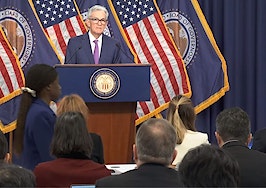At Inman Connect Las Vegas, July 30-Aug. 1 2024, the noise and misinformation will be banished, all your big questions will be answered, and new business opportunities will be revealed. Join us.
A surprisingly strong jobs report sent mortgage rates on the rebound Friday, wiping out much of the improvements would-be homebuyers saw this week.
Employers added 272,000 jobs in May, compared to an average of 232,000 jobs over the past year and far exceeding the consensus view of economists that payrolls would rise by 180,000.
At 4.0 percent, the unemployment rate and number of unemployed people (6.6 million) were little changed from April, but up from 3.7 percent and 6.1 million a year ago, the U.S. Bureau of Labor Statistics reported.
Treasury yields spike

Source: Yahoo Finance.
Yields on 10-year Treasurys, a barometer for mortgage rates, spiked 15 basis points Friday to as high as 4.43 percent, erasing most of this week’s decline. A basis point is one-hundredth of a percentage point.
The CME FedWatch Tool, which tracks futures markets to gauge the odds of the Federal Reserve’s next moves, showed investors who fund most mortgages are now less certain about a Fed rate cut in September.
On Thursday, investors were pricing in a 69 percent chance of one or more Fed rate cuts by Sept. 18. On Friday, bets placed on futures markets suggested the odds of a September rate cut had dropped to 54 percent.
Before Friday’s jobs report, mortgage rates had been on a six-day decline following a stream of data releases beginning May 30 that seemed to point to an economic slowdown and impending Fed rate cuts.
Mortgage rates trending down
Mortgage rate locks tracked by Optimal Blue showed 30-year fixed-rate conforming mortgages averaging 6.88 percent Thursday, down 39 basis points from a 2024 high of 7.27 percent registered April 25.
Optimal Blue data lags by a day, but an index compiled by Mortgage News Daily showed rates on 30-year fixed-rate mortgages surged 12 basis points Friday, in sync with 10-year Treasury yields.
Economists at Pantheon Macroeconomics, who still expect the Fed to cut short term rates by 1.25 percentage points this year, said payroll surprises often are revised away and that most indicators point to a summer slowdown.

Ian Shepherdson
“These numbers kill off any lingering chance of the Fed cutting interest rates in July, but our base case remains that a run of much weaker prints is coming, enabling a September easing,” Pantheon Macroeconomics Chief Economist Ian Shepherdson said in a note to clients.
The response rate to the payroll survey from private employers was only 64 percent, down from an average of 71 percent over the last decade, Shepherdson noted. Small businesses that are feeling the most pressure from high rates may be responding late to the survey, he theorized, which would explain why initial estimates are often revised down.
Shepherdson predicted Federal Reserve policymakers “will leave interest rates at their current high level for a few more months yet. But when the labor market turns, the Fed will be quickly left looking excessively cautious and short-sighted. Accordingly, we continue to look for 125 basis points of easing this year, with a 25 basis-point [cut] in September, followed by 50 basis points at each at the November and December meetings.”
The CME FedWatch Tool shows futures markets see little chance of that happening. Positions taken by investors Friday put the odds of at least 50 basis points of easing by the end of the year at 50 percent, down from 68 percent Thursday.
Get Inman’s Mortgage Brief Newsletter delivered right to your inbox. A weekly roundup of all the biggest news in the world of mortgages and closings delivered every Wednesday. Click here to subscribe.













